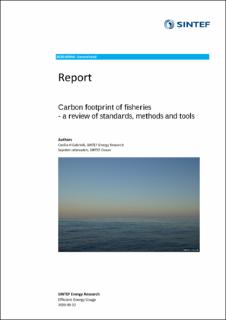Carbon footprint of fisheries - a review of standards, methods and tools
Research report
Published version
Permanent lenke
https://hdl.handle.net/11250/2684522Utgivelsesdato
2020Metadata
Vis full innførselSamlinger
- Publikasjoner fra CRIStin - SINTEF Energi [1640]
- Rapporter fra SINTEF Energi [277]
- Rapporter fra SINTEF Ocean [453]
- SINTEF Energi [1764]
- SINTEF Ocean [1461]
Sammendrag
This report provides an overview of standards, methods, certification schemes, tools, and previous studies related to the carbon footprint (CF) of seafood, both in general but especially related to fishing vessels and refrigeration systems. The aim is to give various perspectives on CF estimations for fisheries, as a basis for further work in CoolFish. A few standards are specifically developed for seafood products; the British PAS2050:2 and the Norwegian NS-9418. Sustainability certifications typically evaluate harvesting pressure, fishing practices and fisheries management. Even if energy use and emissions are often built into the assessment criteria, the CF is rarely specifically addressed. Online tools are available for CF estimations of seafood products, or parts of the product chain. Data for the fishery stage are based on conventional diesel propulsion, and the refrigeration system is only addressed by default values on refrigerant leakage. Previous studies on CF assessment of captured sea-food shows that the fishing vessel's fuel consumption is generally the dominant contributor. Emissions of synthetic refrigerants can also play an important role, as can air transportation. More disaggregated data on fuel use are required to evaluate on-board measures for CF reduction. Further work in CoolFish could contribute with estimations of fuel use for propulsion and refrigeration, for different fishing vessels and operational modes.

